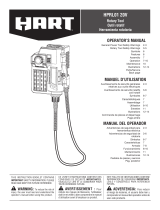
Instrucciones de funcionamiento XFE 7-12 80
18
INSTRUCCIONES DE SEGURIDA ESPECÍFICOS Y SÍMBOLOS
1. Advertencias de seguridad para
el pulido
(a) Esta herramienta eléctrica debe
utilizarse como pulidora. Tener en cuenta
todas las advertencias de seguridad,
instrucciones, representaciones y datos
que se entregan conjuntamente con este
equipo. En caso de ignorar estas
advertencias, se corre peligro de descargas
eléctricas, incendios y/o lesiones graves.
(b)
Esta herramienta eléctrica no es adecua-
da para el amolado, lijado con papel de lija,
efectuar tareas con cepillo de acero o para el
tronzado.
Usos para los cuales es
inadecuado el equipo eléctrico, pueden
causar peligros y lesiones.
(c) Utilizar exclusivamente accesorios que
hayan sido aprobadas específicamente por
el fabricante, para su uso con esta
herramienta eléctrica. El solo hecho de
poder sujetar el accesorio en la herramienta
eléctrica, no garantiza que su uso presente
la seguridad necesaria.
(d) La velocidad de giro de la herramienta
utilizada debe ser como mínimo del valor
que aquella indicada en el equipo eléctrico.
Accesorios que giran a velocidades
superiores que las permitidas, pueden
destrozarse, haciendo volar los trozos por
los alrededores.
(e) Las dimensiones externas y el espesor
de la herramienta utilizada debe
corresponder a las medidas indicadas en el
equipo eléctrico. Herramientas de aplica-
ción mal dimensionadas, no pueden
protegerse o controlarse de modo
suficiente.
(f) Los discos y platos amoladores u otro
tipo de accesorio, deben calzar correcta-
mente sobre el husillo correspondiente de
la herramienta eléctrica. Herramientas de
aplicación que no calzan correctamente
sobre el husillo de la herramienta eléctrica,
giran de forma irregular, vibran con fuerza
y pueden conducir a la perdida del control.
(g) No utilizar accesorios dañados.
Controlar antes de cada uso la herramienta
de aplicación, a fin de determinar si
presenta desprendimientos, fisuras y en el
caso de los platos amoladores la presencia
de fisuras, desgaste abusivo. Si la
herramienta eléctrica o bien la herramienta
de aplicación caen al suelo, controlar si se
ha dañado o bien utilizar una herramienta
sin daños. Una vez controlada y colocada la
herramienta de aplicación, mantenerse
a sí mismo y a otras personas fuera del
plano de rotación, dejando el equipo en
marcha durante un minuto a su velocidad
máxima. Herramientas dañadas general-
mente se destrozan en este tiempo.
(h) Usar equipo de protección personal.
Utilice protección facial integral, protección
para los ojos o gafas protectoras según la
aplicación. Si hiciera falta, utilice una
máscara contra el polvo, protección para el
oído, guantes de protección, calzado
especial o un delantal que mantenga
alejadas de su persona las pequeñas
partículas producto del amolado. Los ojos
deben estar protegidos contra cuerpos
extraños que puedan producirse durante las
diversas aplicaciones. La máscara contra el
polvo o para la respiración debe filtrar el
polvo que se genera durante el amolado.
Si se está expuesto a ruidos fuertes durante
un tiempo prolongado, puede producirse la
pérdida de la audición.
(i) Cuide que otras personas en su cercanía
se encuentren fuera de su zona de trabajo.
Toda persona que acceda a la zona de
trabajo debe estar provista con el
equipamiento de protección adecuado.
Pueden volar trozos de la pieza en proceso
o de la herramienta destrozada,
produciendo lesiones en zonas aún
externas a la zona de trabajo.
(j) Sujetar el equipo de las superficies
aisladas correspondientes cuando
la herramienta de aplicación puede incidir
en conductores eléctricos ocultos o cables
pertenecientes a la red eléctrica.
El contacto con conductores bajo tensión
puede hacer que las partesmetálicas de la
herramienta eléctrica le provoquen una
descarga eléctrica.




















